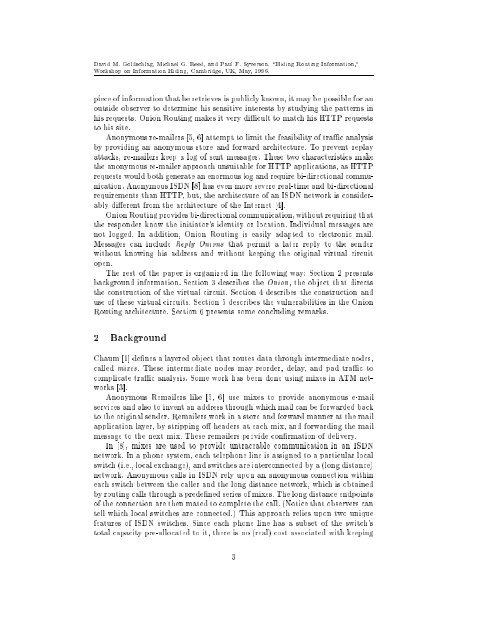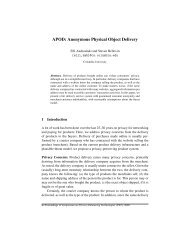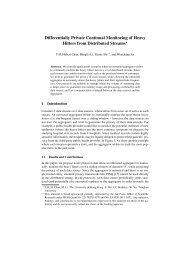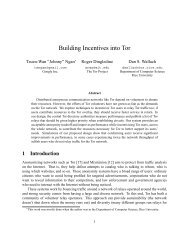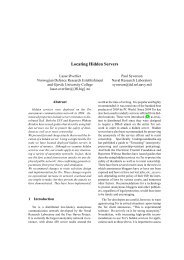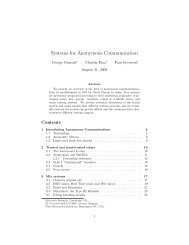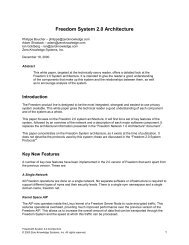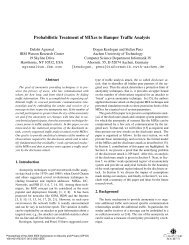Hiding Routing Information - Onion Routing
Hiding Routing Information - Onion Routing
Hiding Routing Information - Onion Routing
You also want an ePaper? Increase the reach of your titles
YUMPU automatically turns print PDFs into web optimized ePapers that Google loves.
David M. Goldschlag, Michael G. Reed, and Paul F. Syverson. \<strong>Hiding</strong> <strong>Routing</strong> <strong>Information</strong>,"Workshop on <strong>Information</strong> <strong>Hiding</strong>, Cambridge, UK, May, 1996.piece of information that he retrieves is publicly known, it may be possible for anoutside observer to determine his sensitive interests by studying the patterns inhis requests. <strong>Onion</strong> <strong>Routing</strong> makes it very dicult to match his HTTP requeststo his site.Anonymous re-mailers [5, 6] attempt to limit the feasibility of trac analysisby providing an anonymous store and forward architecture. To prevent replayattacks, re-mailers keep a log of sent messages. These two characteristics makethe anonymous re-mailer approach unsuitable for HTTP applications, as HTTPrequests would both generate an enormous log and require bi-directional communication.Anonymous ISDN [8] has even more severe real-time and bi-directionalrequirements than HTTP, but, the architecture of an ISDN network is considerablydierent from the architecture of the Internet [4].<strong>Onion</strong> <strong>Routing</strong> provides bi-directional communication, without requiring thatthe responder know the initiator's identity or location. Individual messages arenot logged. In addition, <strong>Onion</strong> <strong>Routing</strong> is easily adapted to electronic mail.Messages can include Reply <strong>Onion</strong>s that permit a later reply to the senderwithout knowing his address and without keeping the original virtual circuitopen.The rest of the paper is organized in the following way: Section 2 presentsbackground information. Section 3 describes the <strong>Onion</strong>, the object that directsthe construction of the virtual circuit. Section 4 describes the construction anduse of these virtual circuits. Section 5 describes the vulnerabilities in the <strong>Onion</strong><strong>Routing</strong> architecture. Section 6 presents some concluding remarks.2 BackgroundChaum [1] denes a layered object that routes data through intermediate nodes,called mixes. These intermediate nodes may reorder, delay, and pad trac tocomplicate trac analysis. Some work has been done using mixes in ATM networks[3].Anonymous Remailers like [5, 6] use mixes to provide anonymous e-mailservices and also to invent an address through which mail can be forwarded backto the original sender. Remailers work in a store and forward manner at the mailapplication layer, by stripping o headers at each mix, and forwarding the mailmessage to the next mix. These remailers provide conrmation of delivery.In [8], mixes are used to provide untraceable communication in an ISDNnetwork. In a phone system, each telephone line is assigned to a particular localswitch (i.e., local exchange), and switches are interconnected by a (long distance)network. Anonymous calls in ISDN rely upon an anonymous connection withineach switch between the caller and the long distance network, which is obtainedby routing calls through a predened series of mixes. The long distance endpointsof the connection are then mated to complete the call. (Notice that observers cantell which local switches are connected.) This approach relies upon two uniquefeatures of ISDN switches. Since each phone line has a subset of the switch'stotal capacity pre-allocated to it, there is no (real) cost associated with keeping3


